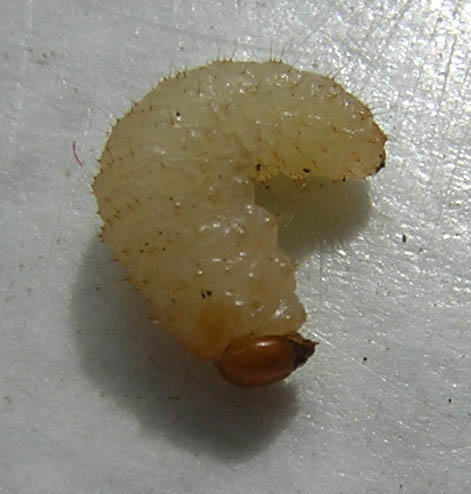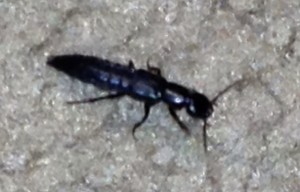Reproduction
Aleochara bilineata, commonly known as Rove Beetles, are known
both as parasitoids and predators to certain populations. In fact
they play a large role in the population stabilization of some
pests, especiall
Rove beetle females do not lay their eggs in or on the host, but
instead they lay them in the soil that is likely to harbor hosts.
Each A. bilineata female can produce approximately nine to 15 eggs
per day or 700 eggs in its lifetime (Broatch
et al. 2008). The
oval-shaped egg is a milky white color after the female lays it. It
varies between 0.38-0.50 mm. After the egg is laid, it will take
three to 19 days for the larva to emerge. Hatching occurs fast;
between five and ten seconds (Gauvin 1998). The larvae must search
for a host first thing after hatching. They have to search through
the soil to find a pupa to consume and live in. Once they find one
(that is not already taken over by
 larva) they chew their way
inside. They settle in the space between the puparium and the nymph.
Then the beetle larva closes the entrance hole by secreting a sticky
substance through the anus which serves as a plug
(Lize et al.
2010).
larva) they chew their way
inside. They settle in the space between the puparium and the nymph.
Then the beetle larva closes the entrance hole by secreting a sticky
substance through the anus which serves as a plug
(Lize et al.
2010).
After the entrance hole is closed, the larva will begin to eat the
nymph. The entire host pupa is consumed (Lize
et al. 2010). A.
bilineata larvae are not able to live outside the host puparium for
very long. If a larva doesn’t find a host in six to eight days it
will usually just die off (Gauvin 1998). Sometimes two or more
larva will enter the same puparium, but only one will live to
maturity. A. bilineata pupates within the host in late fall,
spins its cocoon, and will emerge as an adult when winter is over.
That is where they spend the winter (Shelton 2013). Adult
rove beetles will live 40-72 days (average 46), so normally the
cycle will happen two times per year. The first generation of adults
would be born in early June, the second in August/September
(Gauvin
1998).
Rove beetles perform internal fertilization in order to fertilize
female rove beetles eggs. Like most internally fertilizing insects,
during reproduction the male and female will perform sexual
intercourse and the male will deposit spermatophore into the female’s spermatheca.
(Green 2002). “The male bends its
abdomen over its head and its claspers and aedeagus are extruded.
The copulation (sexual intercourse) lasts between 20 and 65
seconds” (Gauvin 1998). Female
A. bilineata normally
mate many times. They are at sexual maturity the moment they break
out of the puparium. Sometimes they will even mate before they find
something to feed on (Lize et al. 2009).
deposit spermatophore into the female’s spermatheca.
(Green 2002). “The male bends its
abdomen over its head and its claspers and aedeagus are extruded.
The copulation (sexual intercourse) lasts between 20 and 65
seconds” (Gauvin 1998). Female
A. bilineata normally
mate many times. They are at sexual maturity the moment they break
out of the puparium. Sometimes they will even mate before they find
something to feed on (Lize et al. 2009).
Female A. bilineata do not participate in courtship nor do they show
parental care to their offspring (Lize et al. 2009). They also do
not have any specific breeding periods. They are able to mate their
entire lifetime. The whole 46 days of it. It is necessary to mate
multiple times in order for the female’s eggs to be properly
fertilized. Their eggs are sterile when produced- mating is required
to start oogenesis (the maturation of a female’s eggs). Oogenesis
will start 36-72 hours after mating for the first time
(Lize et al. 2009).
An experiment was done by Lize, Cortesero, Poinsot, and Boivin,
scientists from Canada working on studies about the Biology of
Organisms and Populations applied to Plant Protection, specifically
the sperm storage by female A. bilineata. This study concluded that
the more sperm the female can hold, the more fertile she will be
throughout her life. Mating frequently will ensure the fertility of
the eggs throughout the female’s life. Unfortunatly, there is a
cost. Female longevity decreases when females mate at regular
intervals. So although it will decrease her life span; her eggs
will have a better chance at producing viable offspring, so overall
it is beneficial for the female to mate multiple during her lifetime
(Lize et al. 2009)
Check out our reference page for more information on our facts and sources!
For more information on the physical
characteristics of A. bilineata, visit our
form and function page.
Return home